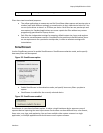
Setting Driver Properties
40 ViewCast
deinterlacing but uses slightly more processing power.
The 3-frame algorithm adds one frame time of latency to video
processing, whereas the 2-frame algorithm (when used in pure
Motion Adaptive mode) does not (see Effects on video latency).
The 2-frame algorithm is the default because of the reduced latency, and
because the quality difference is hard to see.
Note: The choices for deinterlacing algorithms are revised for the
4.6.1 driver. The 2-frame algorithm is an enhancement of
what was formally called the “smooth” algorithm. The 3-
frame algorithm is new for this driver.
Test Mode
The Test Mode option causes the motion adaptive algorithm to enter a
test mode that displays motion pixels as bright white or colored dots in
place of the actual pixels of the image. The dots are mainly along edges
that are in motion. If the motion threshold is set too low there may also
be a random distribution of motion pixels caused by pixel jitter and
instability of the video signal. If the motion threshold is set too high,
there will be few or no altered pixels, and deinterlacing will be
insufficient. Test mode is always automatically exited when you exit the
Adjust dialog.
Restore Defaults
Click this button to restore the default settings.
Help
Click Help to access the user guide.
Close
Click Close to close the window.
Effects on video latency
Note: Drivers prior to 4.6.1 always added one frame time of latency regardless of deinterlacing
settings. The option for zero frames of latency is new to the 4.6.1 driver.
Some deinterlacing modes introduce one frame time of latency to the processing of captured video
frames. That is, the processing adds 33 msec (525-line, NTSC), or 40 msec (625-line, PAL/SECAM) of
delay to the time between end of frame capture, and return to the client. In all cases, this latency is
in addition to the time for processing after capture – which is typically 1 to 5 msec. The one frame of
latency is inserted or not inserted as follows:
If deinterlace mode Off, there are zero frames of latency.
If you request Motion Adaptive and select 2-Frame algorithm, there are zero frames of
latency.
If you request Motion Adaptive and select 3-Frame algorithm, there is one frame of
latency.
If you request Inverse Telecine or Auto, there is one frame of latency. In Auto mode, there
is one frame of latency regardless of whether you select the 2-Frame or 3-Frame algorithm
for Motion Adaptive fallback.
Most applications are not affected by video processing latency. For applications where it is
important to reduce latency, the single most important step is to set deinterlacing mode to Off or to


















